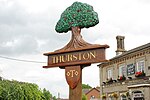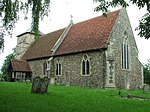Great Whelnetham

Great Whelnetham (sometimes Great Welnetham) is a village and civil parish in the West Suffolk district of Suffolk in eastern England. Located around two miles south of Bury St Edmunds, in 2005 its population was 820.The parish also contains the hamlet of Cocks Green, and the village of Sicklesmere, with which Great Whelnetham is contiguous. Until the Beeching Axe, the area was served by Welnetham railway station on the Long Melford-Bury St Edmunds branch line. In 2019, an excavation of an 4th-century Roman cemetery in Great Whelnetham uncovered unusual burial practices. Of 52 skeletons found, up to 40% had been decapitated, which archaeologists claimed gave new insight into Roman traditions. The burial ground includes the remains of men, women and children who likely lived in a nearby settlement. The decapitated skeletons represent "quite a rare find".
Excerpt from the Wikipedia article Great Whelnetham (License: CC BY-SA 3.0, Authors, Images).Great Whelnetham
Raynsford Road, West Suffolk
Geographical coordinates (GPS) Address Nearby Places Show on map
Geographical coordinates (GPS)
| Latitude | Longitude |
|---|---|
| N 52.206 ° | E 0.751 ° |
Address
Raynsford Road
Raynsford Road
IP30 0TW West Suffolk
England, United Kingdom
Open on Google Maps









